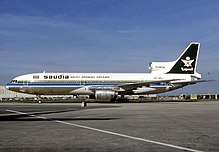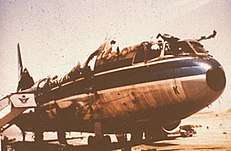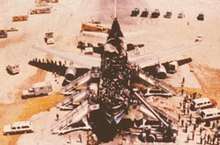Saudia Flight 163
 The sister ship (registration HZ-AHJ) to the aircraft involved in the accident. This aircraft was involved in the Saudia Flight 162 accident. | |
| Accident | |
|---|---|
| Date | 19 August 1980 |
| Summary | In-flight fire in cargo hold, pilot error, and lack of crew resource management |
| Site | Riyadh, Saudi Arabia |
| Aircraft | |
| Aircraft type | Lockheed L-1011-200 TriStar |
| Operator | Saudia |
| Registration | HZ-AHK |
| Flight origin |
Quaid-e-Azam Int'l Airport Karachi, Pakistan |
| Stopover |
Riyadh International Airport Riyadh, Saudi Arabia |
| Destination |
Jeddah International Airport Jeddah, Saudi Arabia |
| Passengers | 287 |
| Crew | 14 |
| Fatalities | 301 |
| Survivors | 0 |
Saudia Flight 163 was a scheduled Saudia passenger flight which caught fire after takeoff from Riyadh International Airport (now the Riyadh Air Base) en route to Jeddah, Saudi Arabia[1] on 19 August 1980. All 287 passengers and 14 crew on board the Lockheed L-1011-200 TriStar (registration HZ-AHK) died from smoke inhalation after the aircraft made a successful emergency landing at Riyadh.
Accident


Almost seven minutes into the flight the crew received warnings of smoke from the cargo compartment.[2]:66–67,98 The next four minutes were spent by the crew trying to confirm the warnings, with the flight engineer going back into the cabin to confirm the presence of smoke in the cabin. The captain decided to return to the airport. The thrust lever for the number two engine (center engine) later became stuck as the fire burned through the operating cable, and the engine was shut down on final approach.
The captain declared an emergency and returned to Riyadh International Airport, where the aircraft landed safely.[3] After touchdown, contrary to the captain's declaration of an emergency landing, the airplane continued to a taxiway at the end of the runway and exited the runway, stopping on the taxiway two minutes 40 seconds after touchdown. The airport fire rescue equipment was stationed at the landing section of the runway, with emergency personnel expecting an emergency stop and evacuation. Why the captain did not immediately order an emergency evacuation of the aircraft is unknown. Because the fire rescue equipment was farther down the runway it took extra time to arrive at the aircraft, which had used the entire length of a 4,000-metre (13,000 ft) runway to slow and then exit onto the taxiway, where it stopped facing in the opposite direction from landing.
On arrival at the aircraft, the rescue personnel did not immediately attempt to open any of the aircraft doors as the two wing-mounted engines were still running. These were shut down three minutes and 15 seconds after the aircraft came to a stop. No external fire was visible at this time, but flames were observed through the windows at the rear of the aircraft. Twenty-three minutes after engine shutdown, the R2 door (second door on the right side) was opened by ground personnel. Three minutes later, a flash fire broke out on the aircraft and it was completely destroyed.[2]:8 Autopsies were conducted on some of the non-Saudi nationals, including the American flight engineer. All perished from smoke inhalation and not burns, which indicated that they had died long before the R2 door was opened. One final transmission was received after the plane stopped, indicating that the emergency evacuation was about to begin.
Most of the bodies were burned beyond recognition. All of the victims were found in the forward half of the fuselage. It took 23 minutes from the engine shutdown until the fuselage was accessed. Saudi reports stated that the crew could not get the plug-type doors to open in time.[4] It is assumed that most passengers and flight attendants were incapacitated during the landing roll, or they would not have attempted to open a door on a moving aircraft.[5] It is known that the aircraft remained pressurized during the landing roll as the cabin pressurization system was on standby, and the aircraft was found with both pressurization hatches almost completely closed. The pressurization hatches should have opened completely on touchdown to depressurize the aircraft. The crew were found still in their flight-station seats. The source of the fire in compartment C3 could not be determined.[2]:78
Aftermath
Investigation
The investigation revealed the fire had started in the aft C3 cargo compartment.[2]:77–78 The fire was intense enough to burn through the cabin floor, causing passengers seated in that area of the cabin to move forward prior to the landing. Saudi officials found two butane stoves in the burned-out remains of the airliner, and a used fire extinguisher near one of them.[2]:35 One early theory was that the fire began in the passenger cabin when a passenger used his own butane stove to heat water for tea.[6] However, this was unable to be confirmed through the findings of the official accident report.[2]:78
Lawsuit
Walter Muller, a former chief of the Policy Analysis Division of the Federal Aviation Administration, filed a lawsuit against Lockheed, Saudia, and Trans World Airlines, an American airline that trained Saudi pilots and supervised the Saudi maintenance program. Muller's brother, Jack A. Muller, and his sister in law, Elizabeth S. Muller, died in the fire. Muller's suit stated that Lockheed allowed for "dangerous materials to be incorporated in the fuselage," that there was no vent system to distribute the gases away from the passengers, and that a sufficient oxygen system did not exist. Muller's suit accused Saudia of not properly maintaining the aircraft and providing safety for passengers, and accused TWA of not properly maintaining the Saudia aircraft and not properly training crew.[7][4][8]
Policy changes
After the event, the airline revised its training and emergency procedures. Lockheed also removed the insulation from above the rear cargo area, and added glass laminate structural reinforcement. The National Transportation Safety Board recommended that aircraft use halomethane extinguishers instead of traditional hand-held fire extinguishers.[7]
Flight 163 encapsulated the further need for an advent of crew resource management. This is evident from the primary lapses in effective communication which prevented the crew from carrying out a final successful evacuation from the aircraft. These lapses are enabled in part by so-called "power distances" between juniors and superiors in workplace settings, relationships found in all societies but emphasized more so in some than in others.[9] "In high power distance cultures, juniors do not question superiors and leaders may be autocratic", leading to situations where a first officer finds it difficult to question decisions made by the captain, conditions which may have been present on Saudia flight 163.[10][9][11] This phenomenon has the capability of affecting flight safety globally, but as the work performed in the cockpit is markedly dependent upon the ability of one worker to crosscheck the work of another and vice versa, the danger is most apparent in individuals brought up in cultures which traditionally revere high-power distances between those in positions of power and their subordinates.[10] In 1982, the British current-affairs program World in Action aired an episode entitled "The Mystery of Flight 163". This documented the accident, and was subsequently used to train pilots in the value of crew resource management.[12]
See also
References
- ↑ "ASN Aircraft accident Lockheed L-1011 Tristar 200 HZ-AHK Riyad International Airport (RUH)".
- 1 2 3 4 5 6 "Aircraft Accident Report, Saudi Arabian Airlines Lockheed L-1011, HZ-AHK, Riyadh, Saudi Arabia August 19th, 1980" (PDF). Federal Aviation Administration. Saudi Arabian Presidency of Civil Aviation. Archived from the original (PDF) on 31 December 2013. Retrieved 26 February 2017.
- ↑ "265 Are Feared Dead As Saudi Plane Burns In Landing at Riyadh". The New York Times. UPI. August 20, 1980. Retrieved 26 February 2017.
- 1 2 "Saudi Fire Negligence Suit Filed". Air Transport. Aviation Week & Space Technology. 27 October 1980. p. 32.
- ↑ Witkin, Richard (August 21, 1980). "Fire on Saudi Plane Believed to Have Started in Cabin: Cockpit Escape Hatch Not Used". The New York Times. NYTimes Co. Retrieved 26 February 2017.
- ↑ "Jetliner fire first started by stove; death toll set at 301". The Morning Record and Journal. United Press International. 21 August 1980. p. 22.
- 1 2 Haine, Edgar A. (2000). Disaster in the Air. Associated University Presses. pp. 67–69.
- ↑ Witkin, Richard (17 October 1980). "Family Suing in Saudi Airliner Fire; Crew Found Partly at Fault". The New York Times.
- 1 2 Helmreich, Robert L.; Davies, Jan (2004). "Culture, Threat, and Error: Lessons from Aviation" (PDF). Canadian Journal of Anesthesia. 51 (6): R2. doi:10.1007/bf03018331.
- 1 2 Trkovsky, Josef (2017). Improved Flight Safety Through Effective Communication Among Multicultural Flight Crew (Ph.D. thesis). Scottsdale, Arizona: Northcentral University. pp. 4, 6–7, 104–114. Dissertation No.10278679 – via ProQuest Dissertations Publishing.
- ↑ Helmreich, RL; Klinect, JR; Wilhelm, JA; Merritt, AC (2001). "Culture, Error, and Crew Resource Management". In Salas, Eduardo; Bowers, Clint A; Edens, Eleana. Improving Teamwork in Organizations: Applications of Resource Management Training. Lawrence Erlbaum Associates. ISBN 0805828443.
- ↑ Karlins, Marvin; Koh, Freddie; McCully, Len; Chan, C. T. "CRM for CRM: Cockpit Relevant Movies for Crew Resource Management". The CRM Advocate.
External links
|
|
- Burian, Barbara K. (2006). "Aeronautical Emergency and Abnormal Checklists: Expectations and Realities" (PDF). NASA Ames Research Center. Retrieved 2017-01-12.
- Thomson, Jim (2013). "Human Behaviour in a Crisis – The Saudia 163 Accident, 1980" (PDF). Safetyinengineering.com. Retrieved 2017-01-12.
- Final Accident Report – General Authority of Civil Aviation
- Picture at PlaneCrashInfo.Com
- Cockpit voice recorder transcript
- AirDisaster.Com Description (Main Database)
- PlaneCrashInfo.Com article on Saudia 163
Coordinates: 24°42′42″N 46°43′37″E / 24.71167°N 46.72694°E